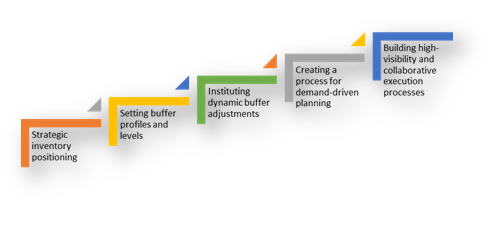Exploring vertical solutions for lean initiatives
Having the least amount of inventory in the system is the natural outcome of the following interdependent and necessary conditions writes Debra Smith in The Measurement Nightmare:
- Producing [only] to order [read: actual demand signals, as opposed to forecasts]**
- Releasing material at the rate of the constraint or critical process
- Reasonably buffering the constraint to ensure it is not starved
- Maximizing the up-time of the constraint
- Purchasing to ensure a buffer of raw materials so the beginning process can start in time to maintain the constraint's buffer
- Ensuring the reliability of all processes to support reasonable buffer levels in front of the critical processes
Smith goes on to re-emphasize the use of interdependent and necessary in the paragraph above by adding the following:
Be careful here! None of these actions can stand by themselves. All are necessary conditions. The key here is to understand the interdependencies among the above conditions. The conflict [and failure to deliver "good results"] arises when one or two of the conditions becomes the focus for driving improvement methodology. The condition is translated into a "key performance indicator" and becomes the end objective of the improvement process.
How it happens
In working with our clients, it is not unusual for us to hear comments like, "We tried being 'lean,' but it just didn't work for us." By this, they typically mean, they tried cutting inventories.
What Smith wisely tells us in The Measurement Nightmare is that "having the least amount of inventory in [your] system" is a result of other factors. Starting out with a metric that leads to mindlessly slashing away at inventories is almost inevitably going to lead to more problems, higher expediting costs, and increased fire-fighting requirements.
This is especially true if you are still building to forecasts—because forecasts are always wrong. Only the size of the error varies with forecasts. So, if you are making to forecasts, chances are you are wasting precious (capacity-constrained resources) resources building things that the customers do not want and are not going to buy. Meanwhile, you are suffering shortages on the things that customers actually do want and are ready to buy.
Taking All the Steps
Demand-driven supply chains have demonstrated proven success when firmly grounded in a program where none of the steps are omitted. The five steps to achieving demand-driven excellence in performance are these:

- Strategic Inventory Positioning
– identifying where in your supply chain strategic buffers will deliver the highest return on investment - Setting Buffer Profiles and Levels – classifying your inventories according the supply-side and demand-side variability, lead-times, and replenishment requirements
- Instituting Dynamic Buffer Adjustments – assuring that inertia does not overtake your system, by instituting dynamic buffer adjustments (generally done with some level of automation)
- Creating a Process for Demand-Driven Planning – demand-driven planning involves using forecasts to manage capacities and to scale buffers according to foreseeable events, among other things
- Building a High-Visibility and Collaborative Execution Process – recognizing that supply chain management must involve all of the functions (e.g., sales, operations, key trading partners) in a collaborative process that seeks to identify changes in the market before the changes become "problems"
With these five steps in mind, we can only reiterate Debra Smith's sage advice:
"Be careful here! None of these actions can stand by themselves. All are necessary conditions" if you want to achieve the highest return on assets for your investments in inventory and capacities.
If you want the best results, don't try to take actions without seeing the effect on the whole system—the whole enterprise, or the whole supply chain, Sage Inventory Advisor can help with this.
[feature_box_creator style="1"]
[/feature_box_creator]
=============================================
NOTES:
* Smith, Debra. The Measurement Nightmare - How the Theory of Constraints Can Resolve Conflicting Strategies, Policies, and Measures. Boca Raton, FL: St. Lucie Press, 2000.
** Producing to actual demand signals does not necessarily mean—and frequently does not result in—"make to order."




